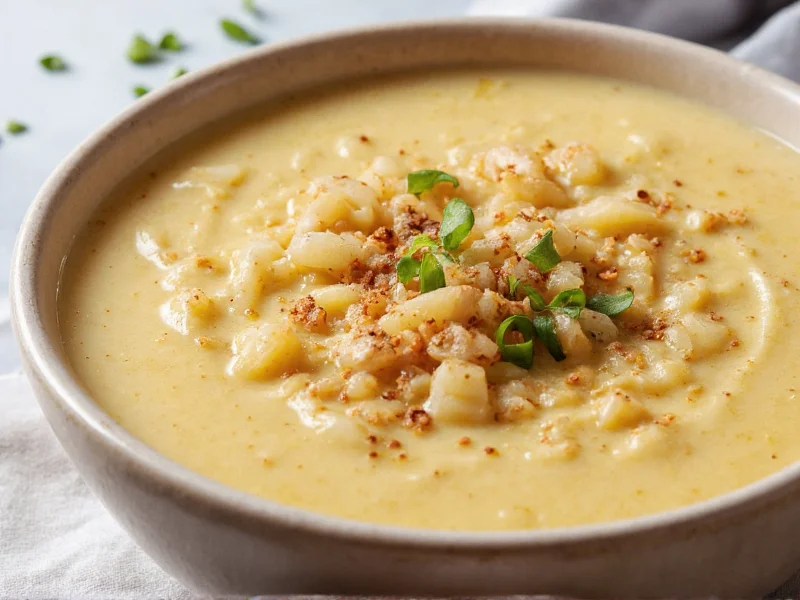Creamy onion soup transforms humble ingredients into an elegant comfort food through careful caramelization and thoughtful creaming techniques. This versatile dish works equally well as a starter for formal dinners or a satisfying weeknight meal. What sets it apart from its French cousin is the incorporation of dairy or alternative creaming methods that create a silky texture without compromising the essential onion flavor profile.
The Science Behind Perfect Creamy Onion Soup
Creating exceptional creamy onion soup requires understanding the chemical transformations that occur during cooking. When onions cook slowly over low heat, their natural sugars undergo caramelization, developing complex flavor compounds. This Maillard reaction creates over 500 different flavor molecules, explaining why properly cooked onions taste so rich and multifaceted. The addition of a small amount of acid (like white wine or vinegar) after caramelization helps balance sweetness while enhancing the soup's overall depth.
Essential Ingredients and Their Roles
While recipes vary, certain elements remain crucial for authentic creamy onion soup:
| Ingredient | Function | Professional Tip |
|---|---|---|
| Yellow onions | Primary flavor base | Use 3-4 pounds for proper caramelization depth |
| Butter and oil | Medium for even cooking | Combine for higher smoke point with rich flavor |
| Dry white wine | Acidity and complexity | Add after caramelization to deglaze the pan |
| Homemade stock | Flavor foundation | Use beef or vegetable depending on preference |
| Heavy cream | Creaminess and body | Add at the end to prevent curdling |
Step-by-Step Preparation Guide
The hallmark of exceptional creamy onion soup is patience during the caramelization process. Rushing this critical stage produces bitter, unevenly cooked onions that compromise the entire dish. Follow these professional techniques for restaurant-quality results:
- Preparation: Thinly slice 3-4 pounds of yellow onions (about 6-8 medium) using a mandoline for consistent thickness
- Caramelization: Cook onions slowly in equal parts butter and oil over medium-low heat for 45-60 minutes, stirring occasionally until deep golden brown
- Building flavor: Add 1/2 cup dry white wine to deglaze the pan, scraping up browned bits
- Simmering: Add 4 cups homemade stock and simmer for 20 minutes to meld flavors
- Creaming: Blend soup until smooth, then return to heat and gradually whisk in 1 cup heavy cream
- Finishing: Season with salt, white pepper, and a pinch of nutmeg just before serving
Variations for Dietary Preferences
Creamy onion soup adapts beautifully to various dietary needs without sacrificing texture or flavor. For dairy-free creamy onion soup, substitute heavy cream with coconut milk or blended cooked potatoes. Those following a low-carb creamy onion soup preparation can reduce added sugars while maintaining richness through extended caramelization. For an extra rich creamy onion soup experience, finish with a swirl of crème fraîche and fresh chives.
Troubleshooting Common Issues
Even experienced cooks encounter challenges with creamy onion soup. If your soup tastes bitter creamy onion soup, you likely burned the onions during caramelization—start over as bitterness cannot be corrected. For creamy onion soup too thin, simmer uncovered to reduce liquid or create a cornstarch slurry. When facing creamy onion soup curdling, remember to temper dairy by gradually adding hot soup to the cream before combining.
Serving Suggestions and Pairings
Creamy onion soup shines when paired thoughtfully. Serve in pre-warmed bowls to maintain temperature, and consider these complementary pairings:
- A crisp green salad with vinaigrette to cut through the richness
- Crusty artisan bread for dipping
- A dry Riesling or Chardonnay that complements the soup's sweetness
- For heartier meals, pair with roasted chicken or seared scallops
Storage and Reheating Techniques
Proper storage ensures your homemade creamy onion soup maintains quality. Cool completely before transferring to airtight containers. Refrigerate for up to 4 days or freeze for up to 3 months. When reheating, do so gently over low heat to prevent separation—never boil cream-based soups. If separation occurs, an immersion blender can restore smoothness. For best results when freezing, omit the cream initially and add it when reheating.











 浙公网安备
33010002000092号
浙公网安备
33010002000092号 浙B2-20120091-4
浙B2-20120091-4